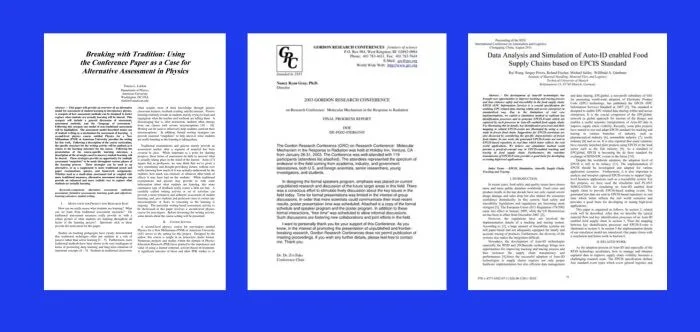There is no doubt that references are one of the most crucial components of academic writing when it comes to the reference section. So, when it comes to including the references for a paper, the question of how many references should a conference paper have often puzzles researchers.
The number isn’t set in stone. As there’s no specific rule on the number of references, the key is relevance and comprehensiveness. Your reference list should encompass all the papers you’ve consulted and reviewed during your research.
This ensures a well-rounded and thorough backing for your arguments. By doing so, your paper not only gains credibility but also reflects the depth of your research. Are you curious about striking the right balance in your reference list? Stay with us as we delve deeper into this topic, offering insights and guidelines to optimize your academic writing.
What Is the Conference Paper and Its Purpose?
A conference paper is an essential academic tool, serving as a medium for scholars to present their findings and ideas at conferences like the Arts, Education, and Humanities Conference. It’s a crucial step in spreading research and fostering scholarly discussions. These papers are typically presented at academic conferences, a vital platform for sharing innovative thoughts and developments.
The primary purpose of a conference paper is to introduce new research findings to the academic community. It allows researchers to receive feedback and engage in meaningful discussions. This exchange of ideas contributes significantly to the evolution of academic disciplines.
Presenting research at conferences often leads to fruitful collaborations and future research opportunities. It also aids in staying abreast of the latest developments and trends within a specific field.
Conference papers often serve as a stepping stone to more comprehensive publications. Researchers use the feedback from these presentations to refine their work. Subsequently, this leads to the publication of more polished research articles in academic journals.
Different Types of Conference Papers
Conference papers come in various formats, each with its unique purpose and audience. Researchers who want to present their papers effectively need to understand these types. From full-length studies to brief reports, conference papers cater to different academic needs and forums.
Full-Length Research Papers
These comprehensive studies present original research with detailed methodology, analysis, and findings. Full-length papers are often peer-reviewed and are considered substantial contributions to the field. They’re ideal for in-depth topic exploration, providing a thorough understanding of the subject matter. These papers typically lead to detailed discussions and are highly valued in academic circles.
Short Papers or Extended Abstracts
Short papers, or extended abstracts, concisely summarize research findings. They’re perfect for ongoing studies where results still need to be conclusive. This format encourages sharing preliminary ideas and invites feedback for further research. Short papers often lead to collaborations and are a great way to test new ideas.
Position Papers
Position papers present an argument or a stance on a specific topic within the field. They’re less about original research and more about opinions and perspectives. This type of paper stimulates debate and discussion, often leading to new insights. They’re instrumental in fields where philosophical or theoretical approaches are prevalent.
Case Study Papers
Focusing on specific instances or examples, case study papers provide in-depth analysis of unique situations. They’re valuable for illustrating theoretical concepts in real-world scenarios. These papers often lead to a better practical understanding of a subject. Case studies are particularly prevalent in fields like social sciences and business.
The diversity in types of conference papers reflects the dynamic nature of academic discourse. Each type serves a unique purpose, contributing to the richness and depth of scholarly communication. Understanding the different types helps researchers choose the best format for their work, ensuring effective communication and engagement with their audience.
How Many References Should a Conference Paper Have?
Determining the ideal number of references in a conference paper can be a nuanced task, as it largely depends on various factors. There’s no fixed number, but rather a range that varies based on the nature and scope of your research. It’s about striking a balance between thoroughness and relevance. Here are a few common factors that affect the number of references used in a conference paper:
Nature of the Research Topic
Research topics that are broad or involve multiple disciplines may require more references. Complex or novel topics often need extensive background information. This ensures comprehensive coverage and context for your work. In contrast, niche topics need fewer, more specialized references.
Length and Depth of The Paper
The length of your paper is a key factor. Longer papers naturally allow for more references, supporting detailed discussions and analyses. Shorter papers might limit the number of references due to space constraints. The depth of analysis in your paper also influences the number of references needed.
Academic Discipline
Different academic fields have varying norms for referencing. Fields with rapidly evolving research, like technology or medicine, might require more recent and numerous references. Conversely, in fields like history or philosophy, fewer, more seminal works might be sufficient.
Publication Guidelines
Conference guidelines often provide specific instructions regarding references. Some conferences might set a maximum or minimum number of references. Always check the conference’s submission guidelines to ensure compliance with their specific requirements.
The number of references in a conference paper is not a one-size-fits-all scenario. The length and depth of a research paper, the academic discipline in which the paper is published, and any specific publication guidelines will influence the publication decision.
Considerable Factors While Writing a Conference Paper
Crafting a conference paper involves careful consideration of several key factors. These elements ensure the paper is impactful, coherent, and well-received in the academic community. From the clarity of the argument to adherence to guidelines, each aspect plays a vital role.
- Audience Understanding: Tailor your paper to the knowledge level and interests of your anticipated audience. This ensures engagement and comprehension.
- Clarity of Argument: Your paper should present a clear, concise argument or thesis statement. This provides focus and direction for your research.
- Research Depth: In-depth research is crucial for adding value and credibility to your paper. It demonstrates thorough understanding and analysis.
- Structure and Organization: A well-organized paper with a logical flow makes it easier for the audience to follow your argument.
- Language and Style: Use clear, precise language appropriate for your academic discipline. Avoid jargon that might alienate broader audiences.
- Reference Quality and Quantity: Include relevant and recent references to support your claims. This enhances the paper’s academic rigor.
- Adherence to Guidelines: Follow the specific format, length, and other submission guidelines of the conference. This shows professionalism and respect for norms.
- Visual Aids and Illustrations: Utilize graphs, charts, and images where appropriate. They can help illustrate points more effectively.
- Feedback and Revisions: Seek feedback from peers and revise your paper accordingly. This improves clarity and overall quality.
Writing a successful conference paper involves a blend of clear communication, thorough research, and adherence to academic conventions. These factors work together to ensure that your paper not only conveys your research effectively but also resonates with your intended audience. Remember, a well-crafted conference paper is a stepping stone to wider recognition and academic discourse.
How Should You Present Your Paper at a Conference?
Presenting a paper at a conference is a significant opportunity to share your research and insights with peers. This process involves preparation, effective delivery, and post-presentation engagement. A structured approach can enhance the impact of your presentation and leave a lasting impression.
Step 1: Understand Your Audience
Begin by researching your audience’s background and interests. This knowledge helps tailor your presentation to their level of understanding and interest areas. Ensuring relevance to your audience is key to engagement.
Step 2: Prepare Your Presentation
Create a clear, concise presentation that highlights your paper’s key points. Use visual aids like slides to emphasize important information. Practice delivering your presentation to ensure clarity and confidence.
Step 3: Engage with the Audience
During the presentation, interact with your audience. Ask questions, invite opinions, and be responsive to their reactions. This engagement makes the session more interactive and memorable.
Step 4: Handle the Q&A Session
Be prepared for a question-and-answer session following your presentation. Listen carefully to questions, respond thoughtfully, and admit if you don’t have an answer. This demonstrates your expertise and honesty.
Step 5: Follow Up Post-Presentation
After your presentation, be available for further discussions. Share your contact information for ongoing dialogue. This opens doors for future collaborations and networking.
You can maximize the impact of your conference experience by knowing your audience, preparing effectively, engaging during the presentation, and following up afterward. Keep in mind that every presentation is an opportunity to grow professionally and personally.
Final Thoughts
Academic writing, especially conference papers, requires precision and thoroughness. From understanding the purpose and types of conference papers to considering the pivotal question, “How many references should a conference paper have?” researchers must navigate through various aspects to ensure their work’s effectiveness.
The key lies in balancing relevance with comprehensive research, tailoring the paper to the audience, and adhering to guidelines. Furthermore, presenting the paper effectively at conferences is crucial; it involves understanding the audience, preparing engaging content, and fostering post-presentation connections.
Mistakes in any of these areas can lead to diminished impact or misinterpretation of the research. Thus, accuracy in every step, from reference selection to presentation delivery, is essential for the credibility and success of a conference paper.








